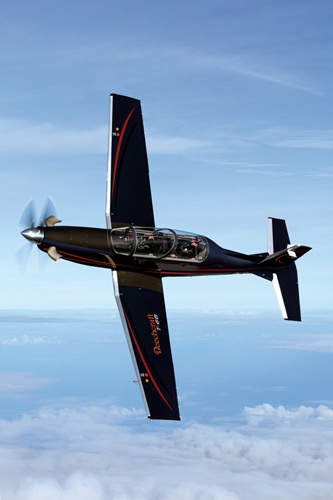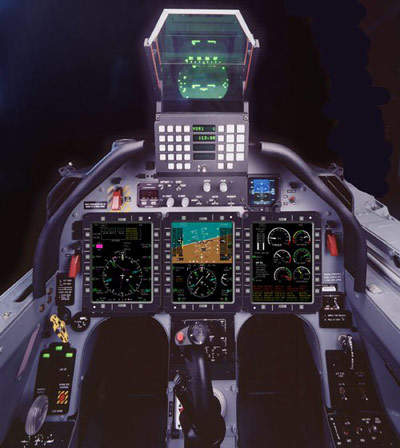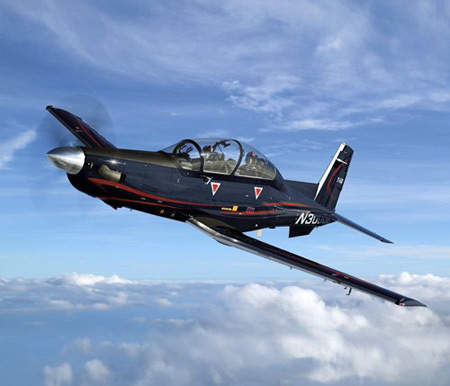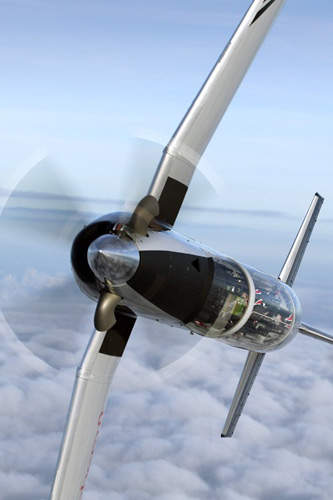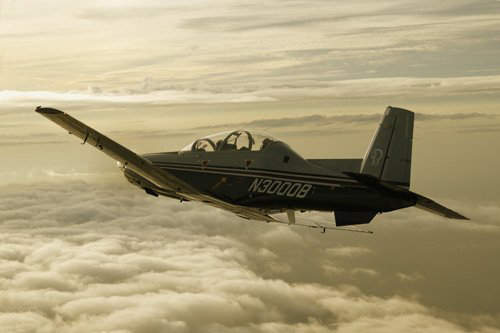In 2006, the US Navy announced it will procure more than 260 of Hawker Beechcraft’s next-generation trainer, the Beechcraft T-6B, which is a significant upgrade to the T-6A already in service with the US Air Force. The T-6B builds on the proven safety and performance of its predecessor with more than 480 T-6A aircraft in service having completed over 650,000 hours of student training.
The Beechcraft T-6B’s open-architecture, advanced avionics suite, including a Head-Up Display (HUD), mirrors the systems and capabilities of current frontline aircraft, enabling the training of complex advanced systems and information management skills.
With effective training extended up to 180 hours, the T-6B training system allows the introduction of advanced concepts and mission skills earlier and in a lower-cost platform, extending the life of more costly advanced training aircraft.
HBC obtained Federal Aviation Administration (FAA) type certification for its T-6B miiltary trainer aircraft on 2 September 2009.
T-6B Texan II orders and deliveries
In December 2007, Morocco requested the Foreign Military Sale (FMS) of 24 T-6B aircraft.
The Government of Iraq awarded a $520m contract to Hawker Beechcraft Corporation (HBC) in December 2008 to supply 36 T-6B Texan II primary trainers. As part of the contract, HBC will also supply six spare PT- 6 engines, 10 spare ALE-47 counter-measure dispensing systems and10 spare AAR-60 missile launch detection systems.
The company will also deliver spare parts, maintenance, support equipment, publications and technical documentation, tanker support, ferry services, personnel training and training equipment.
The US Navy received its first two T-6B Texan II trainer aircraft from HBC on 3 September 2009. The Navy is expected to acquire more than 260 T-6B aircraft to replace its ageing T-34 fleet.
HBC delivered a specially painted T-6 Texan II trainer aircraft to the US Navy in December 2010 as part of the Centennial of Naval Aviation ceremony.
T-6B trainer cockpit
The cockpit is optimised to display critical information and the upgraded avionics facilitate modern embedded training options. The Beechcraft T-6B’s flexible, redundant, open architecture offers an integrated approach for cockpit management.
There are tandem HOTAS (Hands On Throttle And Stick) controls fore and aft for pilot and instructor.
Avionics
The T-6B fully integrated CMC or Flight Visions avionics system uses two powerful mission computers. Integrated navigation and mission data is displayed on the large, 25° Total Field of View (TFOV) Head-Up Display (HUD) and on three high-fidelity 5in x 7in multifunction displays (MFDs). Any one of the three MFDs can access the navigation and mission management pages for the avionics and training systems.
The Up-Front Control Panel (UFCP) provides central control of navigation, air-to-air and air-to-ground master modes from the front and rear cockpits. It also supports radio communication and navigation aid management, weapon selection and programming, waypoint management and designation of markpoints.
The Primary Flight Display (PFD) provides the controls and displays required to manage and present primary flight information to the pilots including attitude, airspeed, altitude and flight path direction.
The Tactical Situation Display (TSD) enhances situational awareness by presenting a scalable plan view of the key elements required for terminal, en route, area and tactical navigation.
The colour digital moving map display (MAP) presents the aircraft’s relationship to the outside physical environment. It also provides key flight, navigation and tactical display of information to give the crew a high degree of situational awareness during flight.
An Engine Instrument and Crew Alerting System (EICAS) provides aircraft and engine system information including status of the engine, propeller, hydraulic, fuel, trim and flap.
The avionics suite also includes a data transfer system for navigation and operation planning and a digital video recorder for mission debrief.
Head up display
The HUD is critical for both navigation and mission performance. It provides the pilot with all critical flight and weapons information, enabling effective and safe aircraft control while manoeuvring. The instructor pilot in the rear cockpit can select the HUD view (outside-world and HUD symbology) on any one of the rear displays via page call-up or the aircraft can be equipped with a dedicated glare shield-mounted HUD repeater.
The HUD has a large 25° Total Field of View (TFOV) and high symbol brightness of over 3,000ft Lamberts, for operation in bright sunlight. The HUD is fully Night Vision Goggle (NVG) compatible. It displays critical flight information such as the flight path marker, pitch reference, climb dive marker and climb dive ladders. Basic flight data is displayed independent of master mode selection or de-clutter level.
The HUD camera is mounted in front of the HUD combiners to avoid obstructing the pilot’s view. The dual cockpit with HUD image displayed on selected MFD or dedicated HUD repeater mounted on the glare shield provides the instructor pilot the ability to give real-time feedback to the student pilot.
Weapons delivery training
The aircraft is fitted with six wing mounted hardpoints. Each wing can accomodate 680kg of armaments and fuel tanks. Embedded within the Mission System Operational Flight Programme (OFP) is a weapons delivery simulation programme that provides the capability for basic air-to-air and air-to-ground combat training. Scoring is based upon the calculated projection of the weapon with delivery cues on the HUD without the need for live ordnance delivery.
The T-6B has an advanced integrated stores management and weapon delivery system with operational aspects similar to those found in modern front-line fighters. The SMS enables the air crew to access and monitor the inventory and status of loaded external stores and armament and to configure racks / pylons.
It also allows the crew to precondition every designated armament and the mission computer to generate necessary gunnery, missile and air-to-ground ordnance weapon employment solution / steering commands.
T-6B advanced training module
The Beechcraft T-6B has an optional advanced training module with full-embedded Air Combat Manoeuvring Instrumentation (EACMI), virtual radar and electronic warfare simulation. These advanced training capabilities increase combat training effectiveness by expanding the training role to include scenarios with both real and virtual participants.
The EACMI has combination of rangeless, real-time training and debriefing features with real-time hit / kill assessment of simulated launches and aircraft and Controlled Flight Into Terrain (CFIT) collision avoidance.
The virtual radar provides simulation of aircraft radar including air-to-air and air-to-ground modes. It is integrated with the EACMI for radar operation with both real and virtual targets. A ground mapping capability uses digital terrain elevation data to provide realistic virtual display over terrain.
For Electronic Warfare (EW) training, the module provides simulation of threats through customisable doctrine and realistic response to aircraft actions including countermeasures, terrain masking and missile hit probability. An aircraft Radar Warning Receiver (RWR) indicator simulates aircraft avionics operation and response.
Engine
The aircraft uses a Pratt & Whitney Canada PT6A-68 turboprop engine which provides a flat rated 1,100hp. The range of the aircraft is more than 1,667km.
Total support
An already well-established logistics infrastructure currently supports more than 450 aircraft at six US and two international locations, with planned support continuing through to 2050.

